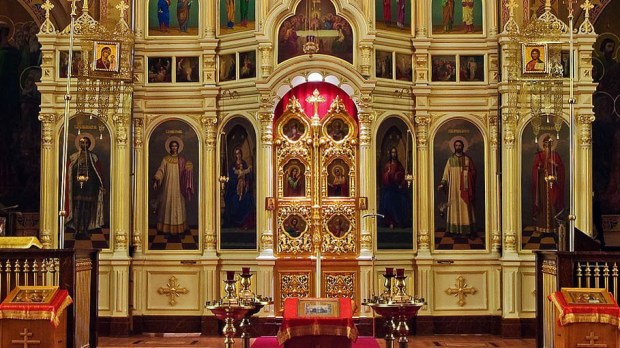For many Eastern Christians, the primary piece of architecture within their churches is an icon screen, also called an iconostasis. It is typically a large wall that separates the sanctuary from the main part of the church where the people stand.
On that wall are many different icons, and a holy door through which the clergy make processions during the Divine Liturgy. The icon screen has developed over time and became what it is now by the 16th century.
According to the Catholic Encyclopedia, “In the early Greek churches there was a slight barrier about waist high, or even lower, dividing the altar from the people. This was variously known as kigklis, grating, dryphakta, fence, diastyla, a barrier made of columns, according to the manner in which it was constructed. Very often pictures of the saints were affixed to the tops of the columns.”
This barrier was similar in appearance to the altar rail that developed in Western churches. At the same time, “in the Western European churches and cathedrals the Gothic church builders put a magnificent wall, the reredos, immediately behind the altar and heaped ornamentation, figures, and carvings upon it until it became resplendent with beauty. In the East, however, the Greeks turned their attention to the barrier or partition dividing the altar and sanctuary from the rest of the church and commenced to adorn and beautify that, and thus gradually made it higher and covered it with pictures of the Apostles, Prophets, and saints. Thus the Greek Church put its ornamentation of the holy place in front of the altar instead of behind it as in the Latin churches.”
One Orthodox church explains that “In its architecture, the entire building represents the theology of our Church. The Sanctuary represents The Church Triumphant (Heaven). The Nave represents The Church Militant (Earth). Heaven is linked to earth by the Iconostasis, which is the successor to the curtain that delineated the Holy of Holies from the rest of the Temple, as described in the Old Testament.”
In the book of Exodus, God instructed Moses to place a veil in front of the Ark of the Covenant, and only the High Priest was allowed to pass through it to the inner chamber. This place became known as the “Holy of Holies” and was replicated in the Temple constructed in Jerusalem. Eastern Christians have incorporated elements of the Temple into the architecture of their churches, respecting the Old Law, while being faithful to the New Law in Jesus Christ.
At first glance the icon screen appears to be a barrier that is meant to separate. Yet, according to Eastern Christians, it is meant to be a sign of unity with Heaven and earth. As one Byzantine church explains, “The icon screen is never a barrier to worship. Some may be inclined to think it restricts what can be seen during worship services. Instead, it is a unifying element, bridging the holy sanctuary and the nave. Together, these symbolically and in reality form the Body of Christ, the Church — the Kingdom of God. As the icon screen signifies this uniting of heaven and earth, in Eastern Churches the priest and faithful also unite their prayers and hymns of praise. Together, they direct their attention to God, towards the altar which faces east. This is the direction cited in Holy Scripture of the Second Coming of Christ. The focus of Liturgy is the divine eternal and timeless sanctity of praise to God, which is why it is called ‘Divine Liturgy.'”
Additionally, the icon screen serves as a strong reminder of the communion of saints. It often features an entire row of icons with pictures of various saints and angels, reminding the faithful that these holy men and women are united with them, most especially during the Divine Liturgy.
The Incarnation and the Second Coming of Jesus Christ are also central parts of many icon screens, featuring the Virgin Mary holding the Child Jesus as well as a prominent icon of Jesus Christ, the Pantocrator, pictured as a Judge at the end of time.
Eastern Christians are instructed that the icons are not to be worshiped, but are used as “windows to Heaven,” gateways to another spiritual realm. Icons are made for this specific purpose, typically never signed by the artist, and painted in such a way they invite worship of God.
Everything in an Eastern church is oriented toward God and has the primary purpose of lifting up a soul from the mundane of this world to contemplate the beauty of Heaven.
Read more:
How to pray with icons: A brief guide

Read more:
What is the difference between a basilica and a cathedral?

